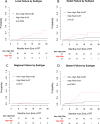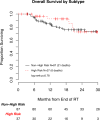Histologic Subtype in Core Lung Biopsies of Early-Stage Lung Adenocarcinoma is a Prognostic Factor for Treatment Response and Failure Patterns After Stereotactic Body Radiation Therapy
- PMID: 27839909
- PMCID: PMC5161605
- DOI: 10.1016/j.ijrobp.2016.09.037
Histologic Subtype in Core Lung Biopsies of Early-Stage Lung Adenocarcinoma is a Prognostic Factor for Treatment Response and Failure Patterns After Stereotactic Body Radiation Therapy
Abstract
Purpose: Stereotactic body radiation therapy (SBRT) has emerged as an effective treatment for early-stage lung cancer. The histologic subtype of surgically resected lung adenocarcinoma is recognized as a prognostic factor, with the presence of solid or micropapillary patterns predicting poor outcomes. We describe the outcomes after SBRT for early-stage lung adenocarcinoma stratified by histologic subtype.
Methods and materials: We identified 119 consecutive patients (124 lesions) with stage I to IIA lung adenocarcinoma who had undergone definitive SBRT at our institution from August 2008 to August 2015 and had undergone core biopsy. Histologic subtyping was performed according to the 2015 World Health Organization classification. Of the 124 tumors, 37 (30%) were a high-risk subtype, defined as containing a component of solid and/or micropapillary pattern. The cumulative incidences of local, nodal, regional, and distant failure were compared between the high-risk and non-high-risk adenocarcinoma subtypes using Gray's test, and multivariable-adjusted hazard ratios (HRs) were estimated from propensity score-weighted Cox regression models.
Results: The median follow-up for the entire cohort was 17 months and for surviving patients was 21 months. The 1-year cumulative incidence of and adjusted HR for local, nodal, regional, and distant failure in high-risk versus non-high-risk lesions was 7.3% versus 2.7% (HR 16.8; 95% confidence interval [CI] 3.5-81.4), 14.8% versus 2.6% (HR 3.8; 95% CI 0.95-15.0), 4.0% versus 1.2% (HR 20.9; 95% CI 2.3-192.3), and 22.7% versus 3.6% (HR 6.9; 95% CI 2.2-21.1), respectively. No significant difference was seen with regard to overall survival.
Conclusions: The outcomes after SBRT for early-stage adenocarcinoma of the lung correlate highly with histologic subtype, with micropapillary and solid tumors portending significantly higher rates of locoregional and metastatic progression. In this context, the histologic subtype determined from core biopsies is a prognostic factor and could have important implications for patient selection, adjuvant treatment, biopsy methods, and clinical trial design.
Copyright © 2016 Elsevier Inc. All rights reserved.
Conflict of interest statement
Dr. Rimner receives research funding from Boehringer Ingelheim and Varian Medical Systems.
Figures
Similar articles
-
Micropapillary and/or Solid Histologic Subtype Based on Pre-Treatment Biopsy Predicts Local Recurrence After Thermal Ablation of Lung Adenocarcinoma.Cardiovasc Intervent Radiol. 2018 Feb;41(2):253-259. doi: 10.1007/s00270-017-1760-8. Epub 2017 Aug 2. Cardiovasc Intervent Radiol. 2018. PMID: 28770314 Free PMC article.
-
Prognostic significance and adjuvant chemotherapy survival benefits of a solid or micropapillary pattern in patients with resected stage IB lung adenocarcinoma.J Thorac Cardiovasc Surg. 2018 Mar;155(3):1227-1235.e2. doi: 10.1016/j.jtcvs.2017.09.143. Epub 2017 Nov 7. J Thorac Cardiovasc Surg. 2018. PMID: 29223834
-
Histology significantly affects recurrence and survival following SBRT for early stage non-small cell lung cancer.Lung Cancer. 2018 Apr;118:20-26. doi: 10.1016/j.lungcan.2018.01.021. Epub 2018 Jan 31. Lung Cancer. 2018. PMID: 29571997
-
Both the presence of a micropapillary component and the micropapillary predominant subtype predict poor prognosis after lung adenocarcinoma resection: a meta-analysis.J Cardiothorac Surg. 2020 Jun 29;15(1):154. doi: 10.1186/s13019-020-01199-8. J Cardiothorac Surg. 2020. PMID: 32600473 Free PMC article. Review.
-
Is there significance in identification of non-predominant micropapillary or solid components in early-stage lung adenocarcinoma?Interact Cardiovasc Thorac Surg. 2017 Jan;24(1):121-125. doi: 10.1093/icvts/ivw283. Epub 2016 Sep 5. Interact Cardiovasc Thorac Surg. 2017. PMID: 27600912 Review.
Cited by
-
Utility of Core Biopsy Specimen to Identify Histologic Subtype and Predict Outcome for Lung Adenocarcinoma.Ann Thorac Surg. 2019 Aug;108(2):392-398. doi: 10.1016/j.athoracsur.2019.03.043. Epub 2019 Apr 12. Ann Thorac Surg. 2019. PMID: 30986416 Free PMC article.
-
Is the Combination of Immunotherapy and Radiotherapy in Non-small Cell Lung Cancer a Feasible and Effective Approach?Front Med (Lausanne). 2019 Nov 7;6:244. doi: 10.3389/fmed.2019.00244. eCollection 2019. Front Med (Lausanne). 2019. PMID: 31788476 Free PMC article. Review.
-
Prognostic factors of patients with pathologic stage I lung adenocarcinoma.J Thorac Dis. 2018 Apr;10(Suppl 9):S1115-S1118. doi: 10.21037/jtd.2018.04.37. J Thorac Dis. 2018. PMID: 29850191 Free PMC article. No abstract available.
-
Micropapillary and/or Solid Histologic Subtype Based on Pre-Treatment Biopsy Predicts Local Recurrence After Thermal Ablation of Lung Adenocarcinoma.Cardiovasc Intervent Radiol. 2018 Feb;41(2):253-259. doi: 10.1007/s00270-017-1760-8. Epub 2017 Aug 2. Cardiovasc Intervent Radiol. 2018. PMID: 28770314 Free PMC article.
-
[Pathological and Molecular Features of Lung Micropapillary Adenocarcinoma].Zhongguo Fei Ai Za Zhi. 2020 Nov 20;23(11):1007-1013. doi: 10.3779/j.issn.1009-3419.2020.102.37. Zhongguo Fei Ai Za Zhi. 2020. PMID: 33203200 Free PMC article. Review. Chinese.
References
-
- Devesa SS, et al. International lung cancer trends by histologic type: male:female differences diminishing and adenocarcinoma rates rising. International journal of cancer. 2005;117(2):294–9. - PubMed
-
- Youlden DR, Cramb SM, Baade PD. The International Epidemiology of Lung Cancer: geographical distribution and secular trends. Journal of thoracic oncology: official publication of the International Association for the Study of Lung Cancer. 2008;3(8):819–31. - PubMed
-
- Asamura H, et al. A Japanese Lung Cancer Registry study: prognosis of 13,010 resected lung cancers. Journal of thoracic oncology: official publication of the International Association for the Study of Lung Cancer. 2008;3(1):46–52. - PubMed
-
- Goldstraw P, et al. Non-small-cell lung cancer. Lancet. 2011;378(9804):1727–40. - PubMed
-
- Travis WD, et al. International association for the study of lung cancer/american thoracic society/european respiratory society international multidisciplinary classification of lung adenocarcinoma. Journal of thoracic oncology: official publication of the International Association for the Study of Lung Cancer. 2011;6(2):244–85. - PMC - PubMed
Publication types
MeSH terms
Grants and funding
LinkOut - more resources
Full Text Sources
Other Literature Sources
Medical



